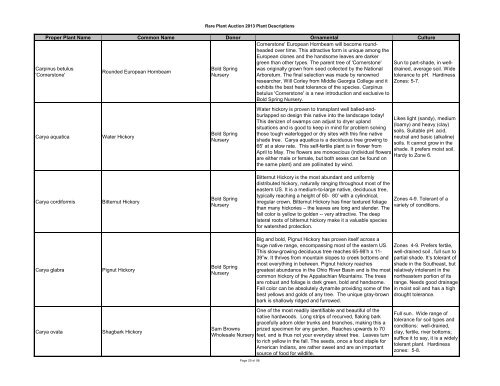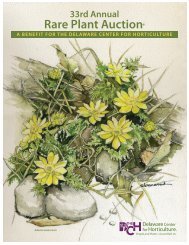Proper Plant Name Common Name Donor Ornamental Culture ...
Proper Plant Name Common Name Donor Ornamental Culture ...
Proper Plant Name Common Name Donor Ornamental Culture ...
You also want an ePaper? Increase the reach of your titles
YUMPU automatically turns print PDFs into web optimized ePapers that Google loves.
Carpinus betulus'Cornerstone'Rare <strong>Plant</strong> Auction 2013 <strong>Plant</strong> Descriptions<strong>Proper</strong> <strong>Plant</strong> <strong>Name</strong> <strong>Common</strong> <strong>Name</strong> <strong>Donor</strong> <strong>Ornamental</strong> <strong>Culture</strong>Cornerstone' European Hornbeam will become roundheadedover time. This attractive form is unique among theEuropean clones and the handsome leaves are darkergreen than other types. The parent tree of 'Cornerstone'Rounded European HornbeamBold Spring was originally grown from seed collected by the NationalNurseryArboretum. The final selection was made by renownedresearcher, Will Corley from Middle Georgia College and itexhibits the best heat tolerance of the species. Carpinusbetulus 'Cornerstone' is a new introduction and exclusive toBold Spring Nursery.Carya aquaticaWater HickoryBold SpringNurserySun to part-shade, in welldrained,average soil. Widetolerance to pH. HardinessZones: 5-7.Water hickory is proven to transplant well balled-andburlappedso design this native into the landscape today!Likes light (sandy), mediumThis denizen of swamps can adjust to dryer upland(loamy) and heavy (clay)situations and is good to keep in mind for problem solvingsoils. Suitable pH: acid,those tough waterlogged or dry sites with this fine nativeneutral and basic (alkaline)shade tree. Carya aquatica is a deciduous tree growing tosoils. It cannot grow in the65’ at a slow rate. This self-fertile plant is in flower fromshade. It prefers moist soil.April to May. The flowers are monoecious (individual flowersHardy to Zone 6.are either male or female, but both sexes can be found onthe same plant) and are pollinated by wind.Carya cordiformisBitternut HickoryBold SpringNurseryBitternut Hickory is the most abundant and uniformlydistributed hickory, naturally ranging throughout most of theeastern US. It is a medium-to-large native, deciduous tree,typically reaching a height of 60- 80’ with a cylindrical,irregular crown. Bitternut Hickory has finer textured foliagethan many hickories – the leaves are long and slender. Thefall color is yellow to golden -- very attractive. The deeplateral roots of bitternut hickory make it a valuable speciesfor watershed protection.Zones 4-9. Tolerant of avariety of conditions.Carya glabraPignut HickoryBold SpringNurseryBig and bold, Pignut Hickory has proven itself across ahuge native range, encompassing most of the eastern US.This slow-growing deciduous tree reaches 65-98’h x 11-39”w. It thrives from mountain slopes to creek bottoms andmost everything in between. Pignut hickory reachesgreatest abundance in the Ohio River Basin and is the mostcommon hickory of the Appalachian Mountains. The treesare robust and foliage is dark green, bold and handsome.Fall color can be absolutely dynamite providing some of thebest yellows and golds of any tree. The unique gray-brownbark is shallowly ridged and furrowed.Zones 4-9. Prefers fertile,well-drained soil , full sun topartial shade. It’s tolerant ofshade in the Southeast, butrelatively intolerant in thenortheastern portion of itsrange. Needs good drainagein moist soil and has a highdrought tolerance.Carya ovataShagbark HickoryOne of the most readily identifiable and beautiful of thenative hardwoods. Long strips of recurved, flaking barkgracefully adorn older trunks and branches, making this aSam Browns prized specimen for any garden. Reaches upwards to 70Wholesale Nursery feet, and is thus not your everyday street tree. Leaves turnto rich yellow in the fall. The seeds, once a food staple forAmerican Indians, are rather sweet and are an importantsource of food for wildlife.Page 20 of 98Full sun. Wide range oftolerance for soil types andconditions: well-drained,clay, fertile, river bottoms;suffice it to say, it is a widelytolerant plant. Hardinesszones: 5-8.




